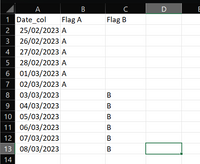FabCon is coming to Atlanta
Join us at FabCon Atlanta from March 16 - 20, 2026, for the ultimate Fabric, Power BI, AI and SQL community-led event. Save $200 with code FABCOMM.
Register now!- Power BI forums
- Get Help with Power BI
- Desktop
- Service
- Report Server
- Power Query
- Mobile Apps
- Developer
- DAX Commands and Tips
- Custom Visuals Development Discussion
- Health and Life Sciences
- Power BI Spanish forums
- Translated Spanish Desktop
- Training and Consulting
- Instructor Led Training
- Dashboard in a Day for Women, by Women
- Galleries
- Data Stories Gallery
- Themes Gallery
- Contests Gallery
- QuickViz Gallery
- Quick Measures Gallery
- Visual Calculations Gallery
- Notebook Gallery
- Translytical Task Flow Gallery
- TMDL Gallery
- R Script Showcase
- Webinars and Video Gallery
- Ideas
- Custom Visuals Ideas (read-only)
- Issues
- Issues
- Events
- Upcoming Events
The Power BI Data Visualization World Championships is back! Get ahead of the game and start preparing now! Learn more
- Power BI forums
- Forums
- Get Help with Power BI
- DAX Commands and Tips
- Help Flag on column
- Subscribe to RSS Feed
- Mark Topic as New
- Mark Topic as Read
- Float this Topic for Current User
- Bookmark
- Subscribe
- Printer Friendly Page
- Mark as New
- Bookmark
- Subscribe
- Mute
- Subscribe to RSS Feed
- Permalink
- Report Inappropriate Content
Help Flag on column
I am trying to create 2 measures one for flag a and another for flag b, and these measures have to change based on the date range filtered and the appearance of all two flags in the recent date.
So in other words if I apply a filter from 25/02/2023 to 08/03/2023 as in the picture the output of the measure flag A must be 0 in all rows because in the last date 08/03/2023 it does not appear, it appears flag so in the measure flag B must be 1 in all rows because in 08/03/2023 it appears as in the picture.
Result expected:
I can get the flag to change dynamically but only on the last row not all rows of all two measures, I don't know if it is possible to do that with a measure.
Thanks.
- Mark as New
- Bookmark
- Subscribe
- Mute
- Subscribe to RSS Feed
- Permalink
- Report Inappropriate Content
Hi,
I am not sure how your datamodel looks like, but I tried to create a sample pbix file like below.
Please check the below picture and the attached pbix file.
Flag A measure expected outcome: =
VAR _slicerlastdate =
CALCULATE ( MAX ( 'Calendar'[Date] ), ALLSELECTED ( 'Calendar'[Date] ) )
VAR _flagAdate =
FILTER ( ALL ( 'Calendar'[Date] ), CALCULATE ( MAX ( Data[Flag A] ) ) = "A" )
RETURN
IF (
HASONEVALUE ( 'Calendar'[Date] ),
IF ( _slicerlastdate IN _flagAdate, 1, 0 )
)
Flag B measure expected outcome: =
VAR _slicerlastdate =
CALCULATE ( MAX ( 'Calendar'[Date] ), ALLSELECTED ( 'Calendar'[Date] ) )
VAR _flagAdate =
FILTER ( ALL ( 'Calendar'[Date] ), CALCULATE ( MAX ( Data[Flag B] ) ) = "B" )
RETURN
IF (
HASONEVALUE ( 'Calendar'[Date] ),
IF ( _slicerlastdate IN _flagAdate, 1, 0 )
)If this post helps, then please consider accepting it as the solution to help other members find it faster, and give a big thumbs up.
Click here to visit my LinkedIn page
Click here to schedule a short Teams meeting to discuss your question.
Helpful resources

Power BI Dataviz World Championships
The Power BI Data Visualization World Championships is back! Get ahead of the game and start preparing now!

| User | Count |
|---|---|
| 19 | |
| 13 | |
| 8 | |
| 4 | |
| 4 |
| User | Count |
|---|---|
| 29 | |
| 19 | |
| 17 | |
| 11 | |
| 10 |




